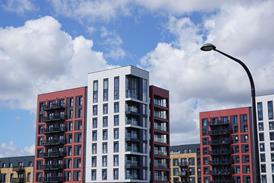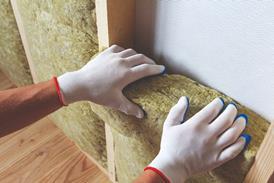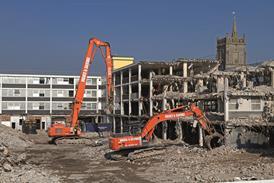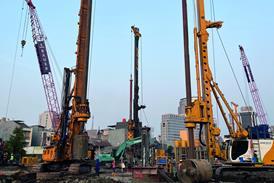Faced with this wasteland and a nebulous brief to design an enclosed space and a platform for the exhibition, consulting engineers Buro Happold decided very early on to divide the servicing of the area into sections to enable flexibility for the final design.
As the siting of exhibits and public services was devised during construction, it was necessary to ensure that services would be available throughout the site when required. Despite the uncertainties, the entire m&e services were designed in only nine months.
The system devised splits the internal area of the Dome into six equal pie-shaped segments. Twelve service pods around the perimeter work in pairs to service each of the segments (see figure 1). All segments have equal capacities although each pair of pods holds slightly different plant.
The primary plant for the entire site is housed within the pods. They are fed from primary distribution service points around a perimeter road. Pod supplies feed into secondary plantrooms within six core buildings around the internal perimeter of the Dome.
From here the services are distributed into a series of six radial and three concentric trenches within the dome which carry electrical cabling and approximately five miles of services pipework.
The radial trenches are generally arranged so an exhibition lies on either side with an access route directly overhead. Two exhibits are serviced from each, with any excess continuing around the circumferential trenches.
The area outside the Dome is currently being developed. The radial trenches extend out across the perimeter road with terminations left to enable further expansion.
The initial exhibition lifetime of two years and short design and build time available were fundamental in the selection of services plant. As building services team leader Ken Carmichael says, "we couldn't be pioneering anything and still hope to meet our deadlines." Instead tried and tested technology was used, albeit on a very large scale. Standard off-the-shelf plant was selected and positioned around the site.
A key design issue was the dismantling of services after the exhibition. The London International Financial Futures and Options Exchange (LIFFE) was consulted by Buro Happold to evaluate resale values of plant on the futures exchange, and items were selected on this basis. The type of transformer specified, for example, was changed as a result of this input.
Equipment is standardised throughout in order to increase the likelihood of resale and minimise downtime if repairs are required.
Much research was put into the initial design baseloads determined. Information was gleaned from trade literature and technical journals covering existing exhibitions. This, in addition to the Buro Happold engineers' personal experience, was used to perform basic heat load calculations to assess required loads, given that the entire contents of the area were yet to be decided.
Electrical services
Exhibits aside, most of the 38 MW of lv electricity is being used to power basic services such as lighting and lifts, and to control the internal temperature of the Dome. As individual exhibit loads will not be known until late in the design process, a decision was made by Buro Happold to provide standard transformers for each area. The installed capacity of power for the landlord's supplies, at 57·5 MVA, is only slightly higher than the original estimate.
The arrangement follows the standardisation strategy with only two sizes of transformer used. The set-up is:
Again, although not an entirely symmetrical distribution, the supply to each sector is equal. All substations contain two transformers, connected in parallel to enable transfer between units if one fails. Considerable resilience is included and most services can carry on running with only one transformer on-line.
It is not clear yet exactly what overcapacity has been created by this standardisation because the exhibits have still to be fully developed. However, as Ken Carmichael says, "the maximum demand is obviously significantly less then the total installed capacity."
A more accurate picture of actual requirements is likely within the next few months, however, the installed capacity will remain throughout the exhibition at least so that all units will be available for bulk resale.
The engineers weren’t trying to do any rocket science on this site.
The scale of the exhibition rules out full standby generation. Life safety systems such as emergency lighting and smoke extract vents are serviced by three 500 kW Petbow generators. The theory being: clear the area then deal with the problem.
HVAC services
Comfort conditions within the Dome have been based on a relative warmth index with the intention of having an internal temperature only a few degrees above ambient.
The heating capacity installed broadly follows the Building Regulations. As an uninsulated structure a maximum load of 25 W/m2 is permitted. This is supplied by 400-450 kW electric heater batteries within the air handling units throughout the dome.
The use of gas was avoided due to the viability of flue and boiler installation over the short-term periods initially designed for.
The basic design of the refrigeration system was established from the research findings. Expected heat loads for each segment were obtained, taking into account natural gains from visitors and equipment. A cooling load was then worked out from first principles for the separate areas within the Dome.
This has all culminated in 18 MW of cooling capacity. The use of an off-site central chiller plant was ruled out by programme constraints, instead it was decided to install on the site. As with the electrical distribution, in order to evenly distribute the overall capacity around the exhibition site, the sectorising system was followed and six separate chiller systems positioned in the service sites being developed.
Each segment contains an equal capacity, provided by four 750 kW Carrier 30GX Global chillers, two in each service pod. These are connected in parallel and grouped onto a common header with a pumpset. Should any problems occur with one of the units, although internal temperatures may drift from the setpoints, the system would still be operational. The six chiller systems run totally autonomously from each other.
It is controversial to some that the hfc refrigerant R134a was used for an exhibition designed to reflect the new millenium. However, this was a decision made by the team after close examination of the available options. The units are fully packaged with single power connection, fit resale requirements and were available in the sizes required.
Currently there is an estimated 3·2 MW overall redundancy: 200 kW in four of the segments and 800 kW in two. However, it should be noted that the design of the internal exhibitions has still to be completed and this is expected to reduce by the final installation.
The use of a complete bems was avoided due to the commissioning time that would be involved, programme timescales simply could not cope. Instead, individual Sauter control systems have been installed in each segment, with motor control centre (mcc) panels in the individual plantrooms. Each one has a complete alarm system for the plant involved in the immediate segment and they are all networked to a central monitoring pc in a main control office onsite.
A full alarm history, including a comprehensive graphical interface of the main plant operating parameters, is recorded on the system. Any common fault alarms are recorded on the pc, unique problems are not.
The facilities management is currently being examined and is almost due to tender. The current idea is to have four engineering managers responsible for monitoring of plant as part of their jobs, and a number of people on site. In contact via walkie-talkies, they would use the mcc's within the plantrooms to locate any problems and take appropriate action.
All units were factory-tested individually and in their packaged form to minimise the amount of commissioning and testing required onsite to purely final stage system testing.
The services in the perimeter area of the Dome are now in place. Preliminary winter performance testing will be carried out in March, with testing for summer condition performance in August. Tenders are currently being submitted for the external areas.
Under contract conditions, NMEC must hand over the entire site, complete and operational, by the end of September 1999. This allows three months for proving, testing and dummy runs before the official opening night.
Life after 2001
The decision by the Labour government to extend the life of the Dome beyond the Millenium Experience has not caused much consternation in terms of the structure. But can the system designed cope over the increasingly larger timescales suggested?
In terms of primary plant, as all units have been engineered to relevant standards and safety curves no real problems should occur, with the preposition that "you can't design m&e equipment that will last two years then fall over the day after that." The real problem would lie with the distribution layout.
This was designed specifically for an exhibition and would prove unsuitable for many other applications. Future buyers proposing to use the space for another purpose may have to significantly, if not entirely, change it.
Buro Happold acknowledges this potential problem but maintains that even if it had been known at the outset, the overall design philosophy would have remained the same. The principles of flexibility involved were necessary due to the lack of knowledge of what was to be included on the site.
Floor 1
A 92·5 m3 sprinkler water tank is sited on this floor in two pods, the volume required for the Category 3 Special system being too large for a single pod. Separate pump rooms have been installed in compliance with BS 5306 for tanks more than 30 m apart. A 500 kW Petbow standby generator has been installed in three pods, each generator servicing two sectors.Floor 2
One of each pair holds a prefabricated packaged plantroom. 150-315 Starbloc close-coupled end-suction Holden & Brooke pumps provide a chilled water flow of 132 litres/s at a head of 200 kPa to a common pipe system which distributes around the dome to null headers. A Holden and Brooke Pressmatic pressurisation unit is included in this plantroom. A Sauter control system is also contained within the plantroom. In eight pods London Electricity packaged hv switchrooms are sited at this level.Floor 3
Two 750 kW Carrier 30GX Global chillers are located on the top level of each pod. These are connected in parallel and grouped onto a common header. A chiller system consists of four units, the pods working as a pair, giving six systems in total to service the Dome and site. All systems run totally autonomous from each other.Pod-u-like
Included in all views of the exhibition since they first entered the public domain, the cylindrical pods surrounding the Dome are now entrenched in the minds of everyone who has seen any photographs or models of the structure. But do they serve any purpose? Housed within these aluminium finned cylinders are all the primary services for the millenium experience. Originally intended to be spherical, creating a futuristic space-station look to the structure, they were to hold part of the exhibition. However, space constraints meant that plant had to be moved outside of the Dome. Engineering consultants, Buro Happold, liked the idea of using the now defunct exhibition spheres. However, it became increasingly difficult to fit square plant into a round space, so the spheres are now cylindrical. Each pod is split into three levels, plant not requiring weather protection was left open to the elements, the remainder was enclosed in packaged plantrooms offsite by GEL and AC Engineering, and installed complete. “Plant location is basically symmetrical in pairs around the Dome, with equal capacities available to the six segments” explained m&e team leader Ken Carmichael. “The contents of each pod varies due to the way the required capacities have been apportioned.” Where plantwork is not required, the space is left empty.Source
Building Sustainable Design



















